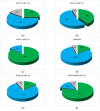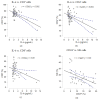Variation in Immune and Inflammatory Blood Markers in Advanced Melanoma Patients Treated with PD-1 Inhibitors: A Preliminary Exploratory Study
- PMID: 40564098
- PMCID: PMC12190117
- DOI: 10.3390/biomedicines13061378
Variation in Immune and Inflammatory Blood Markers in Advanced Melanoma Patients Treated with PD-1 Inhibitors: A Preliminary Exploratory Study
Abstract
Background: Immune checkpoint inhibitors (ICIs) used for the treatment of advanced melanoma have yielded significant results, with long-term responses and improved survival rates, but not for all treated patients. Therefore, predictive biomarkers of response to ICI therapy have been intensively explored. Our study aimed to evaluate the dynamics of peripheral blood lymphocyte variation and their correlation with a set of related inflammatory factors in Nivolumab-treated advanced melanoma patients. Methods: The immunophenotypic assessment of peripheral blood immune cell subpopulations (CD3+, CD4+, and CD8+ T cells; CD19+ B cells; CD16+CD56+ NK cells; and CD4+/CD8+ ratio) was performed by the flow cytometry technique, concomitantly with a complete blood count; levels of S100, IL-6, and TNF-α proteins were quantified in serum by immunoassays, and lactate dehydrogenase (LDH) by a chemiluminescence assay. Results: Approximately 85% and 79% of patients recorded a trend of increasing levels of CD8+ lymphocytes and NK cells, respectively, during therapy. The percentage of NK cells negatively correlated with CD3+, CD4+, and CD19+ cells; the last three cell populations also established negative correlations with the inflammatory neutrophile/lymphocyte ratio (NLR). Furthermore, CD19+ cells were negatively correlated with the systemic inflammatory response index (SIRI) and systemic immune-inflammation index (SII). The evaluation of progression biomarkers showed that LDH levels directly correlated with IL-6 and S100 proteins, but no correlation was found with TNFα; IL-6 levels negatively correlated with percentages of CD3+, CD4+, and CD8+ lymphocytes. Conclusions: Variation in lymphocyte subpopulations during immunotherapy of advanced melanoma patients, associated with other cellular and/or molecular inflammatory markers, might provide insights about immune system response, but additional prospective studies are needed.
Keywords: PD-1 inhibitors; advanced melanoma; cytokines; inflammatory markers; peripheral blood immune cells; predictive melanoma biomarkers.
Conflict of interest statement
The authors declare no conflicts of interest.
Figures






Similar articles
-
Combined programmed cell death protein 1 and cytotoxic T-lymphocyte associated protein 4 blockade in an international cohort of patients with acral lentiginous melanoma.Br J Dermatol. 2025 Jan 24;192(2):316-326. doi: 10.1093/bjd/ljae401. Br J Dermatol. 2025. PMID: 39438074
-
Systemic pharmacological treatments for chronic plaque psoriasis: a network meta-analysis.Cochrane Database Syst Rev. 2017 Dec 22;12(12):CD011535. doi: 10.1002/14651858.CD011535.pub2. Cochrane Database Syst Rev. 2017. Update in: Cochrane Database Syst Rev. 2020 Jan 9;1:CD011535. doi: 10.1002/14651858.CD011535.pub3. PMID: 29271481 Free PMC article. Updated.
-
Systemic pharmacological treatments for chronic plaque psoriasis: a network meta-analysis.Cochrane Database Syst Rev. 2021 Apr 19;4(4):CD011535. doi: 10.1002/14651858.CD011535.pub4. Cochrane Database Syst Rev. 2021. Update in: Cochrane Database Syst Rev. 2022 May 23;5:CD011535. doi: 10.1002/14651858.CD011535.pub5. PMID: 33871055 Free PMC article. Updated.
-
Nivolumab for adults with Hodgkin's lymphoma (a rapid review using the software RobotReviewer).Cochrane Database Syst Rev. 2018 Jul 12;7(7):CD012556. doi: 10.1002/14651858.CD012556.pub2. Cochrane Database Syst Rev. 2018. PMID: 30001476 Free PMC article.
-
Ganoderma lucidum (Reishi mushroom) for cancer treatment.Cochrane Database Syst Rev. 2016 Apr 5;4(4):CD007731. doi: 10.1002/14651858.CD007731.pub3. Cochrane Database Syst Rev. 2016. PMID: 27045603 Free PMC article.
References
-
- Hodi F.S., Chiarion-Sileni V., Lewis K.D., Grob J.-J., Rutkowski P., Lao C.D., Cowey C.L., Schadendorf D., Wagstaff J., Dummer R., et al. Long-term survival in advanced melanoma for patients treated with nivolumab plus ipilimumab in CheckMate 067. J. Clin. Oncol. 2022;40:9522. doi: 10.1200/JCO.2022.40.16_suppl.9522. - DOI
LinkOut - more resources
Full Text Sources
Research Materials

